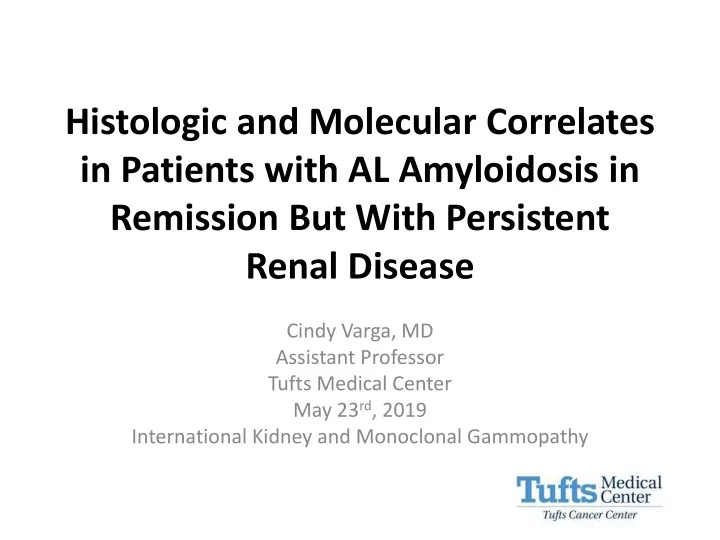

Histologic and Molecular Correlates in Patients with AL Amyloidosis in Remission But With Persistent Renal Disease Cindy Varga, MD Assistant Professor Tufts Medical Center May 23 rd , 2019 International Kidney and Monoclonal Gammopathy
Disclosure of Conflict of Interest ❑ I do not have a relationship with a for-profit and/or a not-for-profit organization to disclose ❑ I have a relationship with a for-profit and/or a not-for-profit organization to disclose Name of for-profit or not-for-profit Description of relationship(s) Nature of relationship(s) organization(s) None Any direct financial payments including receipt of honoraria None Membership on advisory boards or speakers’ bureaus None Funded grants or clinical trials None Patents on a drug, product or device All other investments or relationships None that could be seen by a reasonable, well-informed participant as having the potential to influence the content of the educational activity
AL Amyloidosis • Complete hematologic responses can suppress LC production but organ responses are heterogeneous • There is a lack of insight on the mechanisms by which amyloid deposits drive alterations in the kidney anatomically and functionally
RAIN: Renal AL-amyloidosis Involvement and NEOD001 • Phase 2B multicenter trial that was to enroll 100 patients with: – Persistent proteinuria (>500mg per day) – Previously attained a stable hematologic response to prior anti-plasma cell therapy • All participants were to undergo a kidney biopsy prior to randomization to receive placebo or NEOD001* * M onoclonal antibody that targets amyloid fibrils deposited within organs
Ancillary Studies 1) Transcriptional Profiling 2) Histologic Scoring – Injury score – Amyloid score Hypothesis: Specific signatures of gene expression can be mapped back to certain histologic features
Objective To identify genes that regulate the molecular pathways that make regeneration of renal tissue less or more likely
Baseline Characteristics 24h Patient ID Heme Creatinine eGFR urinary Renal stage status protein (1-3) (mg) 1 VGPR 0.90 101 3645 1 2 VGPR 1.90 42 3249 2 3 CR 1.80 43 6121 3 4 VGPR 1.12 76 17032 2 5 VGPR 1.28 68 5810 2 6 VGPR 0.88 71 1610 1 7 VGPR 0.80 82 4023 1 8 PR 1.14 62 3367 1 9 VGPR 1.23 64 9339 2 10 VGPR 1.00 72 6338 2
Histologic Scoring • 2 expert renal pathologists blinded to baseline characteristics Amyloid Score (AS) Composite Scarring Injury Score (CSIS)
Amyloid Score • 0 = absent • 1+ = minimal; < 25% • 2+ = moderate; 25-50% • 3+ = severe; >50% ** The sum of scores generates the Amyloid Score ( max score of 12 )
Composite Scarring Injury Score % global and Average segmental tubulointerstitial sclerosis fibrosis % COMPOSITE SCARRING INJURY SCORE (CSIS) ** The sum of scores generates the CSIS ( max score of 200 )
Interobserver Agreement Score CSIS AS Cross Tabulations 3 4 5 6 7 8 9 10 11 12 3 2 3 0 0 0 0 0 0 0 0 4 1 0 2 0 0 0 0 0 0 0 5 0 0 0 1 0 0 0 0 0 0 6 0 0 0 1 2 0 1 0 0 0 7 0 1 0 1 1 2 0 2 0 0 8 0 0 0 0 1 3 0 1 1 0 9 0 0 0 0 0 0 0 1 1 1 10 0 0 0 0 0 0 0 0 1 1 Spearman’s correlation = 0.86 Pearson’s correlation = 0.94
Transcriptional Profiling • 10 kidney biopsy cores were received at Michigan Kidney Translational Medicine Core lab – Dissected into glomerular and tubular compartments – Total RNA was extracted and sequenced to generate gene expression profiles
Methods Differential Expression Cluster Supervised Analysis Analysis Tubular Glomerular ▪ eGFR Expression ▪ BUN Profile ▪ Creatinine ▪ Proteinuria Histopathology ▪ Hematologic ▪ AS response ▪ CSIS ▪ sFLCs ▪ Histopathology ▪ AS ▪ CSIS
G1 vs. G2 • Tubular – AS (4.25 vs. 7.00) p = 0.03 • Interstitium (0.125 vs 0.83) p = 0.04 – CSIS (16.75 vs. 32.8) p = 0.16 • Glomerular – AS (4.38 vs. 6.92) p = 0.04 • Mesangium (1.50 vs. 2.75) p = 0.03 – CSIS (17.65 vs. 32.2) p = 0.21
Genes of Interest Genes G1 G2 Function Tubular Unknown + - IQCD Splicing factor + - SF3A2 Peptidyl-amino acid + - ASPHD1 modification Establishment of mitotic spindles, regrowth of Golgi, - + NSFLC1 transport vesicle DNA-binding - + ZSCAN30 transcription RNA binding - + VSIG8 DNA binding, mRNA - + JRK binding Glomerular Cell adhesion, PODXL regulation of + - microvillus assembly All associations significant at q value <= 0.1
Future Investigations • Validate expression patterns by IHC staining – RAIN biopsies – Repository AL biopsies • Compare expression data to controls and other nephropathies in NEPTUNE data set • Multicenter trial – prospective
Acknowledgments • Tufts Medical Center • Renal pathologists – Raymond Comenzo – Samih Nasr – Denis Toskic – Agnes Fogo • Amyloidosis Research • Funding Consortium – 2018 MMRF Fellowship grant – Kristen Hsu – Melissa Warner – NIH/NIDDK grant 2P30-DK- • 081943 George M. O’Brien Michigan Kidney Translational Core Center – Bradley Godfrey – Viji Nair – Felix Eiching – Matthias Kretzler – Markus Bitzer
Recommend
More recommend